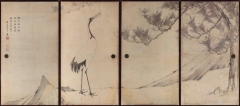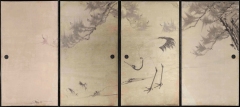TOKYO, May 28, 2008—Canon Inc., in partnership with the Kyoto International Culture Foundation, announced today the selection of 18th century paintings on the partitions in the Ooshoin Room of Kyoto's Rokuon-ji Temple (also known as Kinkaku-ji Temple, or the Golden Pavilion) as the latest undertaking of the Tsuzuri Project,*1 a cooperative initiative that aims to preserve and pass on Japanese cultural assets to future generations using the latest digital technologies. Preparations are currently underway to produce high-resolution replicas of the artwork, which are scheduled for public display in autumn 2010.
The Ooshoin Room partition paintings*2 of Rokuon-ji Temple, comprising 50 decorated sliding-door panels that had adorned the five rooms of Rokuon-ji Temple's Ooshoin, have been designated important cultural properties. The works are now stored in the Jotenkaku Museum within Shokoku-ji Temple, of which Rokuon-ji Temple is a branch temple. The paintings were created by Itoh Jakuchu, considered an artistic prodigy during the Edo period, by order of Daiten Osho, the 113th Head Priest of Shokoku-ji Temple, who recognized Jakuchu's talents at an early stage.
These paintings have been hailed as outstanding examples of Jakuchu's innovative creativity in the field of ink painting. While they have been deemed important cultural properties, as original artwork requiring storage, they are only displayed to the general public at the Jotenkaku Museum a few times each year.
Upon taking into consideration the historical and artistic importance of these paintings, the Tsuzuri Project decided to create high-resolution replicas of all 50 decorated sliding-door panels. The completed recreations will be donated to the Ooshoin Room of Rokuon-ji Temple, where the original panels had initially been on display.
Through the collaboration of the Kyoto International Culture Foundation, with vast experience and know-how in preserving cultural assets, and Canon, which possesses high-resolution, high-image-quality digital imaging technology, the Tsuzuri Project aims to continue contributing to the development of culture and society through art.

"Pine and Crane" by Itoh Jakuchu, Partition Paintings from the Second Ooshoin Room, Rokuon-ji Temple
